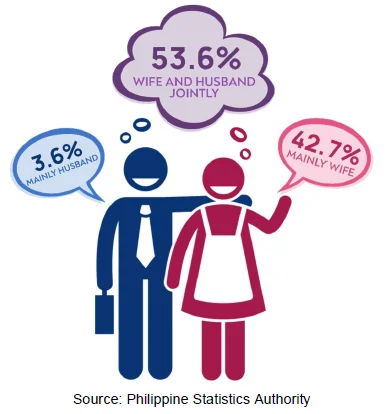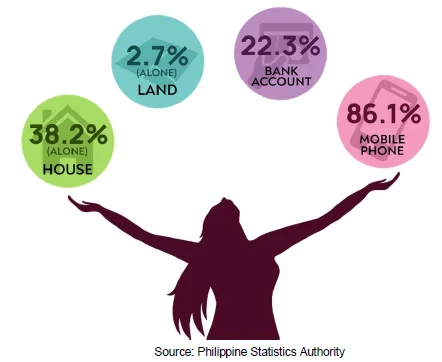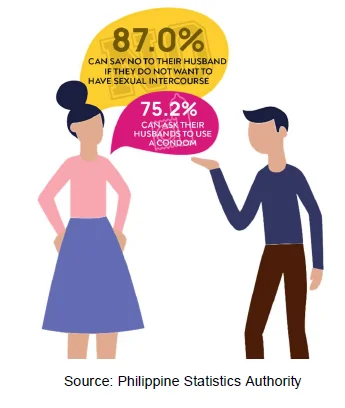Release Date :
Reference Number :
SR 2020-09
The National Demographic and Health Survey (NDHS) is designed to provide data useful for monitoring the population and health situation in the country. Conducted every 5 years by the Philippine Statistics Authority (PSA), the NDHS aims to provide up-to-date information on fertility, family planning, and maternal and child health. The survey also provides inputs to policy formation and monitoring activities, researches and programs on health.
This Special Release explores women’s empowerment in terms of employment, earnings, control over earnings, and magnitude of earnings relative to those of their partners. Moreover, women’s ownership of assets, participation in household decision making and acceptance of wife beating are included in this document.
Employment of married women at 58.2% in 2017
- In the Philippines, about 58 in every 100 currently married women, 15-49 years old were employed in the 12 months preceding the survey. This was three persons less than the employment of married women in 2013 (61%).
-
Among these, 74.8% were paid in cash only while 22.0% were not paid for their work. Some were also paid in cash and in-kind (2.4%) and in-kind only (0.8%).
-
Employment among currently married women in 2017 generally increased with age; 29.0% of currently married women aged 15-19 were employed in the 12 months prior to the survey, as compared to women aged 35-39 (65.0%) and 40-44 (69.7%).
-
The 40-44 and 45-49 age groups of currently married women who are employed were more likely to not get paid for their labor (24.8%) than those in younger age groups (16%-22%).
Husbands and wives share control over wife’s cash earnings in 2017
- More than half of currently married women aged 15-49 with cash earnings decided jointly with their husbands on how their own earnings were spent, and 42.7% decided on their own on how their earnings were used. On the other hand, 3.6% of women said their husbands were the main decision-makers in terms of spending their earnings in 2017.
Figure 1. Percentage of Currently Married Women 15-49 Years Old who Received
Cash Earnings for Employment by Person who Decides How the Wife’s Cash
Earnings are Used, Philippines: 2017

- Contrary to the situation in the national level, more married women from Western Visayas, Central Visayas, Zamboanga Peninsula, Northern Mindanao, and CARAGA (50.0%, 54.0%, 48.0%, 53.9%, and 56.6%, respectively) decided on their own on how their earnings were spent, compared to the wives who made decisions with their husbands.
- Majority of currently married women received cash compensations (49.4%) less than their husbands, 24.1% earned as much as their husbands, and 22.8% married women were paid more than what their husbands got in 2017.
-
Currently married women in urban areas were more likely to make independent decisions regarding how their cash earnings were spent. The same pattern can be observed in the spending decisions made by husbands and wives jointly.
-
Fifty-three percent of employed women in rural areas reported earning less than their husbands, as compared to 45.2% of wives in urban areas.
-
In CAR, more than half of currently married women (50.8%) with cash earnings decided jointly with their husbands on how their own earnings were used while 40.0% of them decided independently. Moreover, 33.6% of married women in CAR claimed to have earned less than their husbands, 32.0% about the same income, and 21.3% of them made more than what their husbands earned.
A minority of women in the Philippines own a house or land, use bank accounts
- In 2017, more than a third (38.2%), 15-49 years old, own a house alone, 17.9% jointly with someone else, and a majority (68.2%) of women have yet to own a house.
-
Joint ownership of land was more common than sole ownership: 6.1% of Filipinas own land jointly with someone else, while only 2.7% acquired land alone.
-
Women’s ownership of a house or land, either alone or jointly, was more common in rural areas than in urban areas in 2017 - 4 in every 10 rural women and 2 in 10 urban women own a house. On the other hand, 15% of rural women and 8% of urban women own land.
Figure 2. Percentage of Women 15-49 Years Old by Ownership of Housing, Land,
Mobile Phone, and Ownership and Use of Bank Accounts, Philippines: 2017

- Across regions, Cagayan Valley had the highest percentage of women owning a house, either alone or jointly with someone, with 48.7%. This was followed by CARAGA and Eastern Visayas with 45.7% and 43.1% shares, respectively. Meanwhile, NCR had the least percentage of women who own a house.
-
In terms of land ownership, Cagayan Valley region also had the largest share of women owning a land, with 33.1%. MIMAROPA came next with 22.4% and SOCCSKSARGEN with 19.5%. NCR (6.8%), Ilocos Region (7.5%), and Eastern Visayas (8.8%) had the least percentages of women who own land.
-
Twenty-two percent of women aged 15-49 had and used a bank account in 2017. Among all regions, NCR recorded the highest percentage of women who had and used a bank account. This was followed by CAR with 31.5%, and CALABARZON with 30.6%. On the other hand, ARMM had the least percentage with 2.7%.
-
Majority of Filipinas, 15-49 years old, owned mobile phones in 2017. NCR (95.5%), CALABARZON (90.9%), Cagayan Valley (89.9%), Central Luzon (89.0%), CAR (88.9%), Ilocos Region (87.4%), and Central Visayas (86.2%) had rates above the national average.
Married women are most involved in making decisions about own health care
- Ninety-six percent of currently married women aged 15-49 had a say on decisions regarding their own health care in 2017. Women’s involvement was highest in Ilocos Region with 99.0%, followed by Eastern Visayas with 98.8%, and CALABARZON with 98.0%. In CAR, about 91% of wives made decisions, either by themselves or jointly with their husband, about their own health care.
-
Other specific decisions such as visits to wife’s family or relatives (93.0%) and making major household purchases (89.1%) also involved a majority of married women in the Philippines.
-
About 8 in 10 wives in the Philippines participated in making decisions regarding the specific matters mentioned above while only 2% of married women said that they were not involved in making any of the three specific decisions.

Some women say wife beating is justifiable under some instances
- In 2017, a minority of women agreed that the husband is justified in hitting or beating his wife if she: neglects the children (8.6%); goes out without telling him (3.4%); argues with him (2.2%); burns the food (1.4%); and refuses to have sexual intercourse with him (1.3%). Further, one in ten Filipinas concurred with at least one of the specified reasons above.
-
Across regions, women living in ARMM were most likely to have attitudes justifying wife beating under at least one specific circumstance while women in NCR were least likely to have such attitudes.
-
In CAR, 8.0% of women thought that wife hitting or beating is justified when the she neglects her children. This was followed by instances such as when the wife argues with her husband (2.8%) and when the wife goes out without telling her husband (2.5%).

Filipina wives can negotiate sexual relations with husband
- Nine in ten currently married Filipinas can say no to their husbands if they did not want to have sexual intercourse. Moreover, seventy-five percent of Filipina wives can ask their husbands to use a condom in 2017.
-
On the regional level, the percentages of women who can refuse to have sexual intercourse with their respective husbands ranged from 63.0% in ARMM to 95.8% in Western Visayas. On the other hand, the share of women who can ask their husbands to use a condom ranged from 56.1% in Northern Mindanao to 84.5% in NCR.
-
More than ninety percent of Cordilleran wives can decline their husbands when it comes to sexual relations. In addition, eight in ten wives from CAR can ask their husbands to use a condom in 2017.
Figure 5. Percentage of Currently Married Women 15-49 Years Old Who Can
Negotiate Sexual Relations with Husband, Philippines: 2017


